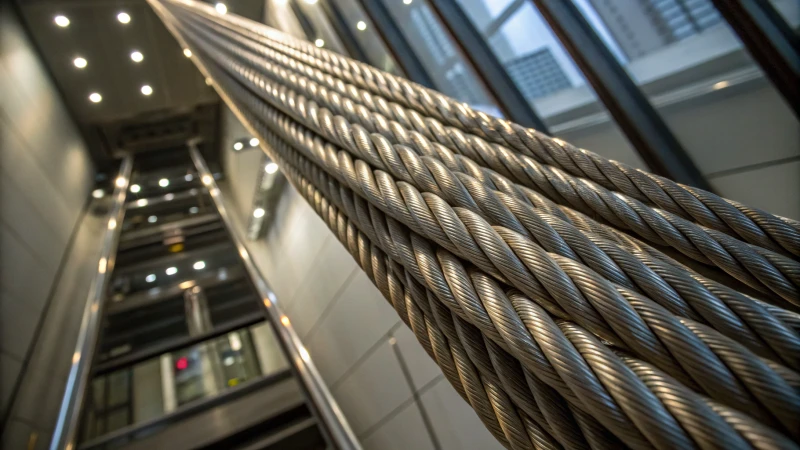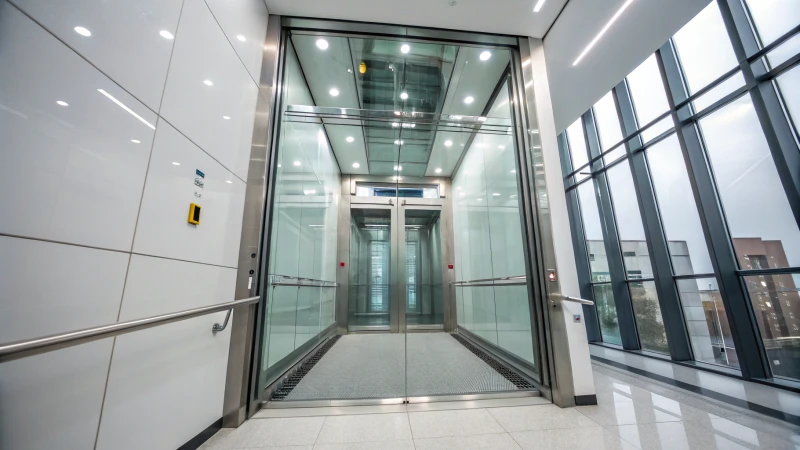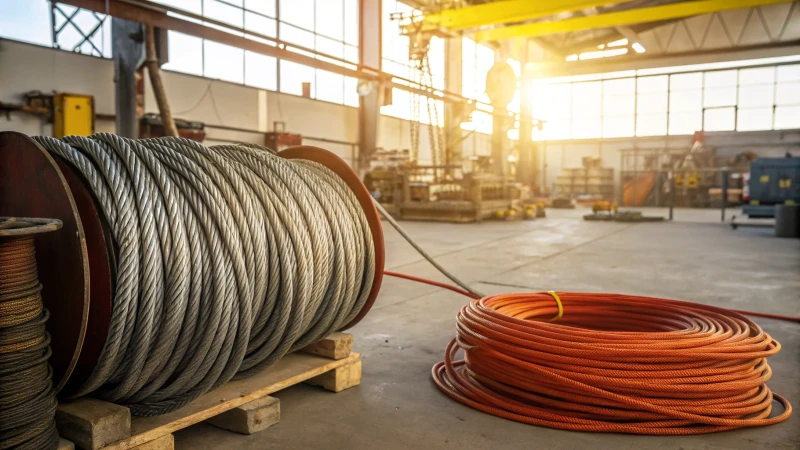
Ever wondered what makes elevators glide so smoothly and safely? The answer often lies in the cables they use.
Steel wire ropes are the go-to for elevators thanks to their incredible strength and durability. On the flip side, polymeric cables shine with their lightness and flexibility, making them a great choice for certain scenarios. The decision hinges on factors like load demands, noise concerns, and maintenance priorities.
I remember standing in an elevator once, contemplating how many times a day we rely on these unseen yet critical components. Steel wire ropes have been the backbone of elevator systems for years, especially when heavy lifting is a must. Yet, polymeric cables are creeping into the spotlight for projects where weight and upkeep can't be compromised. Let's dive deeper into why each might be your best bet depending on your specific needs.
Steel wire ropes have higher tensile strength than polymeric cables.True
Steel wire ropes are known for their superior tensile strength, ideal for heavy loads.
Polymeric cables are heavier than steel wire ropes.False
Polymeric cables are lighter, offering advantages in weight-sensitive applications.
What Makes Steel Wire Ropes the Best Choice for Elevators?
Have you ever wondered what makes elevators glide so smoothly and safely up and down the tallest skyscrapers?
Steel wire ropes are a top choice in elevators for their unmatched tensile strength, durability, and safety. They offer a reliable load-bearing capacity and long service life, making them ideal for demanding elevator applications.

High Tensile Strength
I've always been fascinated by how certain materials perform under immense pressure, and steel wire ropes are a prime example. Their high tensile strength is nothing short of impressive. It's like watching an Olympic weightlifter who can easily hoist enormous loads without breaking a sweat. In elevator systems, this strength is crucial because it ensures passengers can ascend to great heights with complete peace of mind.
Durability and Longevity
I remember a project where durability was the watchword. The last thing anyone wants is to constantly replace components that should withstand the test of time. Steel wire ropes excel in this regard. They endure wear and tear gracefully, much like a vintage car that only seems to get better with age. These ropes are engineered to last, saving time and money in the long run.
| Feature | Steel Wire Ropes | Polymeric Cables |
|---|---|---|
| Tensile Strength | High | Moderate |
| Weight | Heavier | Lighter |
| Flexibility | Less flexible | More flexible |
| Maintenance | Low | Potentially low |
| Noise Level | Moderate | Low |
Safety and Reliability
Safety is more than just a checkbox; it's a mindset. I've always valued products that don't compromise on this front, and steel wire ropes deliver in spades. They maintain their integrity under stress, providing a stable ride even in the busiest urban landscapes. This reliability is like having a trusted friend who never lets you down, no matter the circumstances.
Cost-Effectiveness
I often find myself weighing initial costs against long-term benefits. While steel wire ropes might require a bit more investment upfront, their longevity and minimal maintenance needs make them a savvy choice in the long haul. It's like investing in a quality pair of shoes that you'll wear for years rather than constantly replacing cheaper options.
When evaluating elevator systems for your next project, consider the advantages of steel wire ropes1. Their superior strength and reliability have stood the test of time, continuing to be a favored choice in the industry.
Steel wire ropes have higher tensile strength than polymeric cables.True
Steel wire ropes are known for their exceptional tensile strength, making them superior to polymeric cables in this regard.
Polymeric cables require more maintenance than steel wire ropes.False
Polymeric cables potentially have low maintenance needs, similar to steel wire ropes.
When Should You Consider Using Polymeric Cables Instead?
Imagine you're in the middle of a high-rise project and your elevator system needs a lift—literally. Could polymeric cables be the solution? Let's uncover when they might just outshine traditional steel wires.
Consider using polymeric cables when you need to prioritize weight reduction, flexibility, and noise reduction. They're perfect for environments requiring minimal maintenance and high-speed elevators where reducing system weight is crucial.

Key Factors Favoring Polymeric Cables
Weight and Flexibility
I'll never forget the time I was working on a project that required transporting materials up a 50-story building. The challenge wasn't just about getting the load up there; it was about doing it efficiently. That's where polymeric cables came in. They're up to 50% lighter than steel wire ropes. Imagine trying to haul a grand piano up those floors—wouldn't you prefer the lighter option? This weight advantage is a game-changer for high-speed elevators2, where every pound matters for efficiency and performance.
Noise Reduction and Maintenance
In another instance, I was involved with a residential project where noise was a significant concern. The residents didn't want to hear the elevators clattering every time someone took a ride. Polymeric cables are much quieter and more flexible, making them an ideal choice for such settings. Plus, they save you from constant maintenance checks, which can be both costly and time-consuming.
| Comparison | Polymeric Cables | Steel Wire Ropes |
|---|---|---|
| Weight | Lighter | Heavier |
| Flexibility | More Flexible | Less Flexible |
| Noise Level | Lower | Higher |
| Maintenance | Less Frequent | More Frequent |
Environmental Suitability
I remember visiting a facility prone to corrosion issues—every piece of metal seemed to rust overnight. In such environments, polymeric cables can offer greater resistance compared to steel. They're perfect for facilities dealing with corrosive materials or high humidity levels.
When Steel Wire Ropes Still Reign
Even with all these benefits, there are times when steel wire ropes are irreplaceable. If you're involved in heavy-duty applications like mining operations3, where strength and durability are non-negotiable, steel ropes are your best bet. Their robust nature ensures safety and reliability under extreme conditions.
Understanding these nuances has helped me—and will hopefully help you too—make informed decisions based on specific project needs. Balancing cost4, performance, and long-term benefits is crucial. So next time you're planning a project, consider these factors to determine if polymeric cables might be the right choice for your application.
Polymeric cables are 50% lighter than steel wire ropes.True
Polymeric cables offer significant weight reduction, crucial for applications like high-speed elevators.
Steel wire ropes require less maintenance than polymeric cables.False
Polymeric cables typically require less frequent maintenance, reducing long-term costs.
How do maintenance needs differ between steel wire ropes and polymeric cables?
Choosing the right cable means understanding its maintenance demands, and it's a lot like picking the perfect pair of shoes—each has its own perks and quirks.
Steel wire ropes require frequent inspection and lubrication due to corrosion risk, while polymeric cables need less upkeep but must be checked regularly for wear and tear.

Comparing Maintenance Requirements
Understanding the maintenance needs5 of steel wire ropes versus polymeric cables requires a detailed exploration of their characteristics:
| Feature | Steel Wire Ropes | Polymeric Cables |
|---|---|---|
| Corrosion Resistance | Requires regular lubrication to resist rust | Naturally corrosion-resistant |
| Wear and Tear | High durability but prone to corrosion | Less durable, prone to wear |
| Flexibility | Rigid, needs careful handling | Flexible, easier installation |
Inspection Frequencies
When I first started learning about steel wire ropes and polymeric cables, it felt a bit like comparing apples to oranges. Yet, as I dived deeper into their maintenance needs, I realized each one had unique characteristics:
Steel wire ropes are incredibly tough but demand regular attention. Here's what that looks like:
- Visual checks: Keep an eye out for fraying or kinks.
- Lubrication: Essential to prevent rust from taking hold.
- Tension monitoring: Ensures proper alignment and operation.
Polymeric cables reminded me of those low-maintenance plants—you know, the kind that thrives on a bit of benign neglect:
- Surface wear checks: Essential, especially with UV exposure.
- Connection integrity: A priority to prevent failures.
Cost Implications
When weighing costs, it's a balancing act. Steel wire ropes have a heftier initial price but offer a longer lifespan if well-maintained. However, the frequent care they need can add up over time.
-
Steel Wire Ropes:
- Higher upfront cost but offer durability.
- Ongoing maintenance can be pricey.
-
Polymeric Cables:
- Less expensive initially but may not last as long.
- Lower maintenance costs due to less frequent upkeep needs.
Exploring how these aspects affect industries such as construction6 or mining7 can provide critical insights for procurement strategies. It's all about aligning the strengths and maintenance needs of each material with their intended use. Doing so can significantly optimize performance while reducing downtime and costs. This approach is vital to achieving success in any demanding application environment.
Steel wire ropes need regular lubrication to prevent rust.True
Steel wire ropes are prone to corrosion and require lubrication to resist rust.
Polymeric cables require more frequent inspections than steel ropes.False
Polymeric cables need less frequent inspections due to natural corrosion resistance.
How do steel wire ropes and polymeric cables compare in cost?
Ever been caught between the sturdy reliability of steel and the sleek efficiency of polymers? I certainly have, and it’s a choice that can shape your project’s success.
Steel wire ropes are durable and economical for heavy loads, whereas polymeric cables, though costlier upfront, save on maintenance and are lighter, ideal for specialized uses.

Comparing Initial Costs and Long-term Value
Imagine you're setting up a massive construction project, like I did once, and you're faced with choosing between steel wire ropes8 or polymeric cables. The initial cost of steel might seem enticing because it's lower, especially when every penny counts at the start. Steel ropes are the old faithful of high-tension applications, providing sheer strength and confidence.
However, polymeric cables came with their own set of perks for me, despite their heftier price tag. In scenarios where weight was a factor—like in high-speed elevators I’ve worked on—the energy savings they offered over time were undeniable. It's an upfront investment that pays back in reduced operational costs.
| Option | Initial Cost | Long-term Value |
|---|---|---|
| Steel Wire Ropes | Lower | High durability; less frequent replacement |
| Polymeric Cables | Higher | Energy savings; low maintenance |
Maintenance and Operational Considerations
I learned the hard way how important it is to think beyond the purchase price. Steel wire ropes, reliable as they are, need regular TLC—lubrication and corrosion checks, which can add up over time.
On the other hand, polymeric cables felt like a breath of fresh air. Their resistance to environmental wear meant fewer maintenance headaches, saving me both time and money, especially in remote sites where maintenance was a logistical nightmare.
Environmental and Installation Impacts
The weight difference was a game-changer for me during installation phases. Steel ropes, although robust, required more manpower and time to install. In contrast, the lightweight nature of polymeric cables cut down on labor costs significantly.
Moreover, consider the environmental impact: steel production has a larger carbon footprint compared to polymeric alternatives. This may influence procurement decisions9 for companies prioritizing sustainability.
Assessing these factors holistically has always been my approach, ensuring each choice aligns with the specific demands and dynamics of my projects.
Steel wire ropes are cheaper than polymeric cables initially.True
Steel wire ropes have lower upfront costs compared to polymeric cables.
Polymeric cables require more maintenance than steel wire ropes.False
Polymeric cables need less maintenance due to their environmental resistance.
Conclusion
Steel wire ropes offer high strength and durability for elevators, while polymeric cables provide lightweight flexibility and low maintenance, making each suitable for different applications based on project needs.
-
Explore the economic advantages of choosing steel wire ropes, focusing on their cost-effectiveness over time. ↩
-
Explore why polymeric cables are preferred in high-speed elevators to understand their benefits over traditional materials. ↩
-
Discover why steel wire ropes remain essential in mining operations for their unmatched strength and reliability. ↩
-
Learn about the cost implications of choosing polymeric cables over steel wire ropes to assess budgetary impacts. ↩
-
Exploring this topic can provide a clearer understanding of maintenance demands and help in choosing the right material. ↩
-
This can help identify benefits of using polymeric cables in construction, highlighting potential efficiency gains. ↩
-
Discovering how these materials compare in mining can inform decisions on durability and cost-effectiveness. ↩
-
Learn about the durability and strength benefits of steel wire ropes, especially for high-load applications in various industries. ↩
-
Understand how steel and polymer production impact the environment, aiding in eco-friendly procurement decisions. ↩

